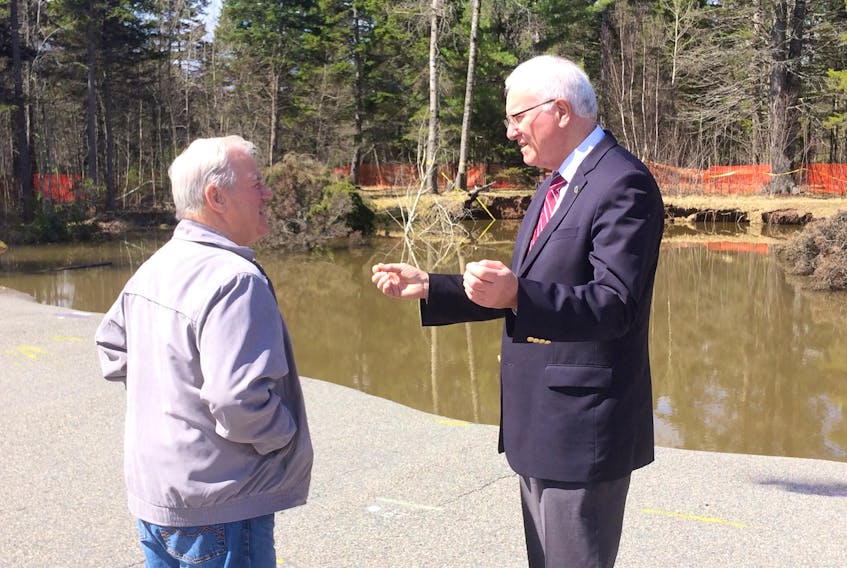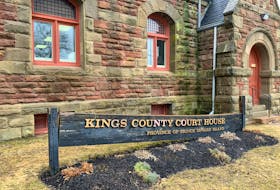OXFORD, N.S. — Cumberland-Colchester MP Bill Casey is urging the federal and provincial ministers of transportation to come up with funding to determine if the sinkhole in Oxford’s Lions Park could impact a vital transportation corridor through Cumberland County.
“I’m very concerned about this and the fact the report suggests further incidents could occur in the area,” Casey said Friday. “The report also recommends a study of the highway. I thought the highway was part of the study, but it was not.”
The MP said he has written provincial Transportation and Infrastructure Renewal Minister Lloyd Hines and federal Transport Minister Marc Garneau asking them to expand the study to include the highway.
A geotechnical report into last August’s sinkhole that closed the Lions Park in Oxford has indicated the land in the park is unstable and that other sinkholes could develop on the property. It’s for that reason the Oxford Lions Club has announced its intention Thursday to look for another piece of land in the community for its park.
It will also determine whether its community centre can be moved, sold or demolished.
Casey, who announced the federal share of study’s funding in April, said he has looked at the geological maps and noticed the area around the park and the Trans-Canada Highway connecting Amherst and Truro is in a karst area that is prone to the development of sinkholes.
“I’m asking both ministers to study what’s under the highway because of the high likelihood of further events,” Casey said. “There are sinkholes on both sides of the Trans-Canada Highway for several kilometres and they are scary. When you look at a topographical map, it’s a very likely event another sinkhole can occur.”
Casey said he’s not trying to be alarmist but wants to be proactive because the sinkhole last August showed they can develop very quickly.
A depression, that could be part of another sinkhole, has already been noted on the onramp to the westbound lane of the highway. Casey said it has been there for several years and he added he has talked to people who were involved in the highway’s construction years ago who were concerned about the sinkhole issue at that time.
“It’s a key transportation link for Nova Scotia and Newfoundland with the rest of Canada. We can’t take the risk because if something happened it could be a dangerous situation. Sinkholes happen fast,” Casey said. “They need to do this as quickly as possible. It’s a worrisome situation.”
The MP said the report GHD Engineering said a ground penetrating radar trial survey done last fall was unsuccessful as the ground penetrating radar was unable to provide the depth of investigation.
He said the report suggests expanding the program to include the Trans-Canada as well as infrastructure east of Highway 321.
Oxford’s CAO Rachel Jones said Nova Scotia’s Transportation and Infrastructure Renewal Department was invited to participate in the original study but declined. She’s hoping it will reconsider.
“We had developed a potential proposal that would have included the Trans-Canada in the testing, so we could cross that out and we were hoping the provincial government would jump on board and benefit from the fact the equipment and the personnel were already mobilized, and they didn’t,” she said. “We had no permission to test on the Trans-Canada Highway and we didn’t”
She said it’s Oxford’s position that there is a concern there and there should be at least benchmark testing, if nothing else, and then monitor it the same as the town is going to do for the town’s main street.
It’s also a concern for the county’s regional EMO co-ordinator Mike Johnson.
“I’m not a geologist, but it’s not uncommon when you look at soil composition and you have an area that you do testing on it’s quite likely that the rest of the area has similar characteristics. You don’t need to be a geologist when you see the other sinkholes and the LIDAR mapping that’s been done. It would be prudent on the part of our federal and provincial ministers to have a look to see what the potential is.”
He said it would also be wise to have a plan should something happen.
“Most of the area in question is uninhabited, but there is the Trans-Canada Highway running right through it,” Johnson said. “We can hypothetical it to death, but the nature of the highway and the ground it’s sitting on it would be prudent to say the potential there is less than it is in the test area.
“Not only that, but if you have an issue, it would be prudent to look at what they’d do if a problem arose so they’re not starting from Ground Zero.”
Cumberland South MLA Tory Rushton said other government departments came to the table prior to the study, but TIR didn’t. He said he toured the area with the department’s deputy minister, Paul LaFleche, to urge TIR to come to the table for further study.
“I’m following up with letters to the premier and the minister of transportation,” Rushton said. “The town has already indicated it wants to have a deeper look and I support that. Hopefully we can get the province and the federal government to look at this.”
Transportation and Infrastructure Renewal spokesperson Peter McLaughlin told the Amherst News in an email that regular testing is done on Highway 104.
“To date, we have not found any defects that would be cause for any concern,” he said. “The safety of travellers on our provincial roads and highways is our highest priority. Our highway staff are regularly monitoring the Highway 104, as well as the ramps and other provincial road infrastructure in and around the Oxford area, for changes and to ensure it is safe at all times.”
McLaughlin said a special test vehicle is used which obtains measurements related to road smoothness and any wheel rut depths in the pavement driving lanes. It also photographs pavement condition and nearby road conditions along the travel path.









